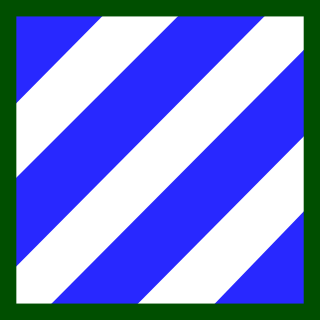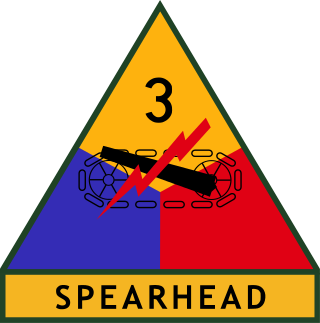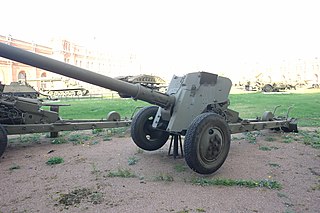
The 3rd Infantry Division (3ID) is a combined arms division of the United States Army based at Fort Stewart, Georgia. It is a subordinate unit of the XVIII Airborne Corps under U.S. Army Forces Command. Its current organization includes a division headquarters and headquarters battalion, two armored brigade combat teams, one aviation brigade, a division artillery, a sustainment brigade and a combat sustainment support battalion along with a maneuver enhancement brigade. The division has a distinguished history, having seen active service in World War I, World War II, the Korean War, and the Global War on Terror. The Medal of Honor has been awarded to 61 members of the 3rd Infantry Division, making the division the most honored in the Army.

The 1st Armored Division, nicknamed "Old Ironsides", is a combined arms division of the United States Army. The division is part of III Armored Corps and operates out of Fort Bliss in El Paso, Texas. It was the first armored division of the United States Army to see battle in World War II. Since World War II, the division has been involved in the Cuban Missile Crisis, Persian Gulf War, Iraq, Afghanistan, and several other operations. The division has also received numerous awards and recognition.

V Corps, formerly known as the Fifth Corps, is a regular corps of the United States Army headquartered at Fort Knox, Kentucky and Camp Kościuszko, Poland.

The 36th Infantry Division ("Arrowhead") also known as the "Panther Division", the "Lone Star Division", "The Texas Army", and the "T-patchers", is an infantry division of the U.S. Army and part of the Texas Army National Guard. The 36th Infantry Division was first organized during World War I (1914–1918) from units of the Texas and Oklahoma National Guards. After the war, the division was reformed as an all-Texas unit, and was called to service for World War II (1937–1945) on 25 November 1940, was deployed to the European Theater of Operations in April 1943, and returned to the Texas National Guard in December 1945.

The 1st Infantry Division (1ID) is a combined arms division of the United States Army, and is the oldest continuously serving division in the Regular Army. It has seen continuous service since its organization in 1917 during World War I. It was officially nicknamed "The Big Red One" after its shoulder patch and is also nicknamed "The Fighting First". The division has also received troop monikers of "The Big Dead One" and "The Bloody First" as puns on the respective officially sanctioned nicknames. It is currently based at Fort Riley, Kansas.

The 2nd Armored Division was an armored division of the United States Army. The division played important roles during World War II in the invasions of Germany, North Africa, and Sicily and in the liberation of France, Belgium, and the Netherlands. During the Cold War, the division was primarily based at Fort Hood, Texas, and had a reinforced brigade forward stationed in Garlstedt, West Germany. After participation in the Persian Gulf War, the division was inactivated in 1995.

The 1st Cavalry Division is a combined arms division and is one of the most decorated combat divisions of the United States Army. It is based at Fort Cavazos, Texas. It was formed in 1921 and served during World War II, the Korean War, the Vietnam War, the Persian Gulf War, with the Stabilization Force in Bosnia and Herzegovina, the Iraq War, the War in Afghanistan as well as Operation Freedom's Sentinel and Operation Inherent Resolve. As of July 2023, the 1st Cavalry Division is subordinate to the III Armored Corps and is commanded by Major General Thomas M. Feltey.

The 3rd Armored Division was an armored division of the United States Army. Unofficially nicknamed the "Third Herd", the division was first activated in 1941 and was active in the European Theater of World War II. The division was stationed in West Germany for much of the Cold War and also participated in the Persian Gulf War. On 17 January 1992, still in Germany, the division ceased operations. In October 1992, it was formally inactivated as part of a general drawing down of U.S. military forces at the end of the Cold War.

The VII Army Corps of the United States Army was one of the two principal corps of the United States Army Europe during the Cold War. Activated in 1918 for World War I, it was reactivated for World War II and again during the Cold War. During both World War II and the Cold War it was subordinate to the Seventh Army, or USAREUR and was headquartered at Kelley Barracks in Stuttgart, West Germany, from 1951 until it was redeployed to the US after significant success in the Gulf War in 1991, then inactivated in 1992.

III Corps is a corps of the United States Army headquartered at Fort Cavazos, Texas. It is a major formation of the United States Army Forces Command.

The 34th Infantry Division is an infantry division of the United States Army, part of the National Guard, that participated in World War I, World War II and multiple current conflicts. It was the first American division deployed to Europe in World War II, where it fought with great distinction in the Italian Campaign.

The Battle of 73 Easting was fought on 26 February 1991, during the Gulf War, between Coalition armored forces and Iraqi armored forces. It was named for a UTM north–south coordinate line that was used as a phase line by Coalition forces to measure their progress through the desert. The battle was later described by Lt. John Mecca, a participant, as "the last great tank battle of the 20th century." This battle took place several hours after another, smaller, tank battle at Al Busayyah.

Brigadier General Michael A. Ryan was a General Officer in the United States Army.

The Battle of Wadi al-Batin, also known as the Battle of Ruqi Pocket, took place before the beginning of the Desert Storm operations on 16 February 1991. This is not to be confused with the "Battle of Wadi al-Batin" which was fought later in the four-day ground war between elements of the 1st Cavalry Division and the Iraqi Republican Guard.

General Donn Albert Starry was a United States Army four-star general who served as commanding general of United States Army Training and Doctrine Command from 1977 to 1981, and as commander in chief of United States Readiness Command from 1981 to 1983.

The 7th Infantry Regiment is an infantry regiment in the United States Army. In its 200-year history it has participated in 12 wars, been awarded 78 campaign streamers, and 14 unit decorations. The regiment has served in more campaigns than any other infantry unit in the United States Army.

Robert William Cone was a United States Army four-star general who last served as the commanding general of United States Army Training and Doctrine Command (TRADOC). He assumed command of TRADOC on 29 April 2011. He previously served as the commander of Fort Hood and III Corps on 22 September 2009, with which he deployed to Iraq in February 2010, and served as the Deputy Commanding General for Operations, United States Forces – Iraq, until February 2011. Prior to that, he served as the Special Assistant to the Commanding General of TRADOC. He retired in 2014.

Paul Edward Funk II is a retired four-star general in the United States Army who last served as the commanding officer of the Army Training and Doctrine Command. He previously served as the 60th Commanding General of III Corps and Fort Hood, Texas, and as the Commanding General, Combined Joint Task Force – Operation Inherent Resolve. Funk was born at Fort Hood, Texas, graduated from Fort Knox High School, and was commissioned an Armor Officer through ROTC upon graduation from Montana State University in 1984. His first assignments saw him serve in a variety of Armor and Cavalry roles to include Tank Platoon Leader, Company Executive Officer, Squadron Commander of 1st Squadron, 7th Cavalry Regiment and Brigade Commander of 1st Brigade Combat Team, 1st Cavalry Division located at Fort Hood.

Thomas Sease James Jr. is a retired United States Army lieutenant general who last served as the 39th Commanding General of the First United States Army headquartered at Rock Island Arsenal, Illinois. He held his latest position from October 29, 2018, to July 8, 2021, after having previously served as Deputy Chief of Staff for United Nations Command/Combined Forces Command/United States Forces Korea.

Major General Albert Cowper Smith was an officer in the United States Army. He is most noted for his service as Commanding General of the 14th Armored Division during the later part of World War II. Smith and his division liberated Prisoner-of-war camps, Oflag XIII-B and Stalag VII-A in April 1945.





















